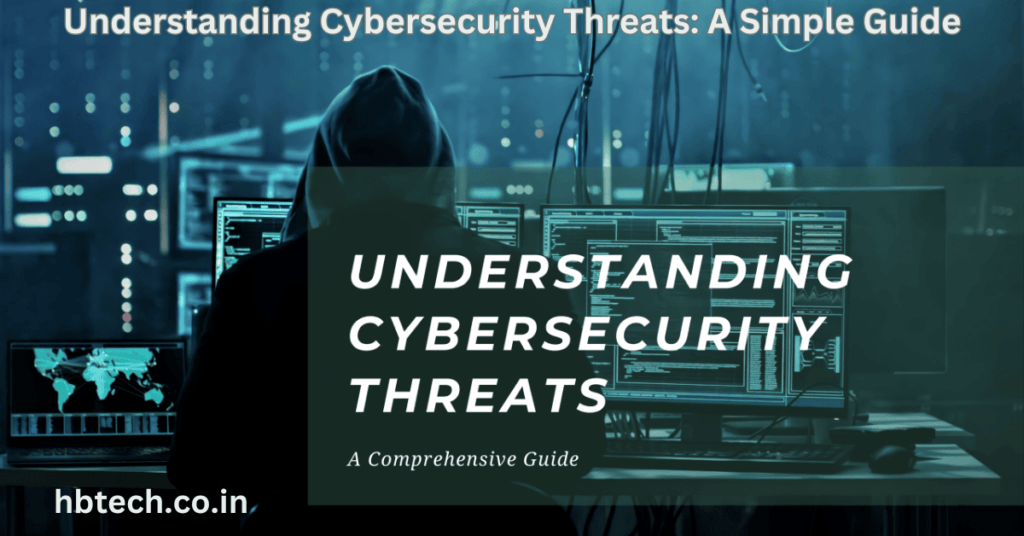Today, we live in a world where digital technology is everywhere, from our phones to our workplaces. With this technology, however comes a serious issue cybersecurty threat. These threats such as hackers stealing data or scammers tricking people online, are something we all need to understand. Let’s take a simple look at what these threats are, why they matter and how to stay safe
Cybersecurity Threats
Cybersecurity threats come in many forms and target weaknesses in computers, phones, networks and even social media accounts. The goal of these attacks varies, but they often involve stealing data, damaging systems or causing confusion. The impact can range from personal data loss to massive financial costs for companies.
Common Cybersecurity Threats
- Malware (Malicious Software)
Malware is harmful software that infects computers and other devices. It includes viruses, spyware, ransomware, and more. Malware can come from infected email attachments, risky websites, or downloads. Ransomware, in particular, is damaging because it locks up data and demands payment to unlock it, causing huge problems for people and organizations. - Phishing Attacks
Phishing is when scammers pretend to be trustworthy sources like banks or popular websites to trick people into sharing sensitive information, such as passwords or credit card details. Phishing often happens through fake emails or messages. Some scams are even personalized known as “spear phishing,” making them harder to spot - Distributed Denial-of-Service (DDoS) Attacks
In a DDoS attack, hackers flood a network with so much traffic that it slows down or stops completely. These attacks are often aimed at companies and websites that depend on online access, causing big losses if customers can’t get to the site. - Man-in-the-Middle (MitM) Attacks
In MitM attacks, hackers secretly intercept communications between people, often by taking advantage of weak public Wi-Fi networks. They can use this access to steal data, passwords or even take over accounts. Using secure networks and encryption helps prevent these attacks - Insider Threats
Insider threats come from people within an organization, whether by accident or on purpose. Sometimes employees accidentally expose data and other times, they misuse access to steal or harm data. Training and strict access controls are ways companies can reduce these risks.
New and Growing Cybersecurity Threats
As technology changes, so do cyber threats. Here are a few of the latest trends:
- AI-Powered Attacks
Artificial Intelligence (AI) is being used not only for good but also by hackers to make attacks more effective. AI helps hackers find weak spots faster, making their attacks harder to stop. - Deepfake Scams
Deepfake technology can create fake videos or audio recordings that look and sound real. Hackers and scammers have used deepfakes to impersonate people tricking employees or even fooling entire companies into making payments or sharing private data - Internet of Things (IoT) Vulnerabilities
Smart devices, like security cameras or smart thermostats, are often not very secure. When hackers get control of these devices, they can use them to access larger networks, posing a real danger for people and organizations alike
Tips to Protect Yourself and Your Data
Luckily, there are simple steps everyone can take to stay safe online.
- Use Strong Passwords and Two-Step Authentication
Strong passwords and two-factor authentication (like a code sent to your phone) add layers of security to your accounts. This makes it harder for hackers to get in, even if they have your password - Keep Your Software Updated
Software updates often include fixes for security weaknesses. Keeping your devices and applications updated ensures that they are less vulnerable to attacks - Watch Out for Phishing Scams
Be cautious of emails or messages that look suspicious. Don’t click on links or dowload attachments from unknown sources. When in doubt go directly to the website or contact the company yourself. - Use Secure Networks
Public Wi-Fi is often not secure. Avoid accessing sensitive accounts, like online banking, on public networks. If you need to consider using a Virtual Private Network (VPN) for added security. - Back-Up Important Data
Ransomware and other attacks can lead to data loss. Regularly backiing up your files, either to a secure cloud or external drive helps make sure you won’t lose everything if your device is compromised.
What’s Next for Cybersecurity?
The world of cybersecurity is always evolving. New technologies, like AI and quantum computing, are being developed to help protect against these threats. However with these advances come new challenges and cybercriminals are quick to adapt. Staying informed and being cautious are two of the best defenses anyone can have
Cybersecurity threats are a real part of modern life, but with a bit of awareness and good habits, you can greatly reduce your risk. Whether you’re an individual protecting personal data or a company safeguarding customer information, a proactive approach to cybersecurity is essential for staying safe in our digital world
Frequently Asked Questions(FAQs)
What are the most common types of cybersecurity threats?
Cybersecurity threats include malware, phishing attacks, distributed denial-of-service (DDoS) attacks, man-in-the-middle (MitM) attacks and insider threats. Each poses unique risks to data and system security.
How does malware impact devices and data?
Malware is a type of malicious software that infects devices through downloads, emails, or websites. It can steal personal data, lock files (as with ransomware),and even render devices unusable
What is phishing, and how can I avoid it?
Phishing is a scam where attackers impersonate trusted organizations to trick individuals into sharing personal information. Avoid it by not clicking on suspicious links, verifying email senders and goig directly to a website to log in if you’re unsure.
What are DDoS attacks, and who do they affect?
A Distributed Denial-of-Service (DDoS) attack overwhelms a website or network with excessive traffic, making it inaccessible. These attacks mainly target online businesses and services, leading to downtime and potential revenue loss
What are insider threats, and how are they different from other cyber threats?
Insider threats come from within an organization, either intentionally (employees misusing access) or accidentally (employees exposing data by mistake). Strong access controls and employee training help manage these risks
What are some of the newest cybersecurity threats?
Emerging threats include AI-powered attacks, deepfake scams and vulnerabilities in Internet of Things (IoT) devices. These technologies give attackers new ways to exploit security gaps.
Why is backing up data important for cybersecurity?
Backing up data protects against data loss in events like ransomware attacks or system failures. If data is backed up you can restore it without paying ransoms or losing important information.
What steps are organizations taking to protect against cybersecurity threats?
Organizations are using technologies like AI-based threat detection, enhanced user authentication, employee training and regular software updates to protect against threats. Additionally many are implementing strong data encryption and access control measures.
Will cybersecurity threats continue to evolve in the future?
Yes, cybersecurity threats will keep evolving as technology advances. Staying informed, practicing good cybersecurity habits and using the latest security measures will be essential for ongoing protection.









